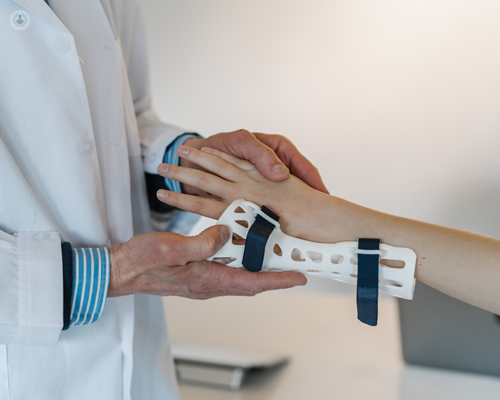Carpal tunnel syndrome article series: Treatment
Written by:When the median nerve, a major nerve in our arm and wrist, is compressed, it can cause discomfort and disrupt everyday routines due to the symptoms it causes. More seriously, it can lead to permanent nerve damage if it goes untreated.
Renowned consultant orthopaedic surgeon Miss Samantha Tross speaks to Top Doctors for a three-part series about this common and sometimes debilitating, yet treatable, condition. In this article, find out about how carpal tunnel syndrome is treated and diagnosed by this expert specialist.

How is carpal tunnel syndrome treated?
Treatment is based on treating any underlying condition. So, if you have, let's say, a fracture or a joint dislocation, you'd want to reduce that and fix it. If it's due to inflammation of the tendons, if it's something like a rheumatoid or an inflammatory condition, you'd prescribe anti-inflammatory medication to treat that.
In most cases of pregnancy, you'd normally try not to do anything whilst the patient is pregnant or even until after they're pregnant because it takes time for that fluid to dissipate. So instead of treating the condition, you make more space for the nerve by releasing the fibrous tissue, the connective tissue above the bones, that forms the tunnel, the roof of the tunnel.
When you do that, the bones underneath relax and then in the gap that forms as the bones relax that band of tissue separates and a gap occurs in between and the body eventually forms a scar tissue to bridge the gap but the space beneath is much bigger overall. That increase in space is what helps to relieve the tension on the nerve and therefore improve the symptoms.
So, in most cases we just release the connective tissue structured under the flexor retinaculum and not treat the underlying condition. If there's a treatable underlying condition then you need to deal with that.
Does carpal tunnel syndrome treatment involve prevention?
We mentioned direct treatment of the condition and talking of surgery. In between that, there's things that can be done.
When you bend your wrist, you flex it, you bend it; that reduces the space around the tunnel and increases the pressure within the tunnel. That makes the symptoms much worse so you want to prevent bending the wrist, so we give patients a wrist splint. It has a metal bar in it that stops you being able to bend the wrist. So that's one treatment. It's usually when you're in bed at night, when you're sleeping, our wrist automatically relaxes and symptoms get worse at night. So, you want to wear the splint at night time. If you wear it too often, throughout the day, consistently, you may get stiffness of the wrist and you don't want that so we tend to try and use it at night.
You should modify your activity so if you're working with tools with a lot of vibrations, that can increase pressure inside the carpal tunnel so you want to:
- Reduce that activity;
- Take painkillers;
- You can also do an injection of steroids into the carpal tunnel, and that would help reduce any inflammation.
I mentioned inflammation of the tendons which can swell and cause problems so if you put an anti-inflammatory in there which you can either take by tablet or via injection, these are ways that it can be treated non-surgically. Sometimes you need more than one injection; not everybody necessarily responds to injections but it may be worthwhile trialling that first and sometimes you need more than one. If you have two injections and it still hasn't responded, then really, you're thinking about surgery.
We would also go straight to surgery if someone has very severe symptoms and if there's associated muscle weakness. Because once you start to get muscle weakness it's very difficult to build back the muscle strength. There are certain times where you have to go straight to surgery. If the symptoms aren't that severe, a trial of conversative treatment may occur.
How is a carpal tunnel syndrome diagnosis made?
A history of the symptoms that we just talked about and on examination, there's certain tests that we can do. The most specific and sensitive test is to have a nerve conduction and electric myography where we test the contraction of the muscles. This is a very good test. The most sensitive test of all is taking your thumb and pressing above the area where the nerve is and if that really brings on the pain. That's the most sensitive test.
For more information about this condition, read Miss Tross’ introduction to carpal tunnel syndrome in part one and her guide to surgery in part three (Coming soon).
If you’re interested in Miss Tross’ top-class treatment for carpal tunnel syndrome and other orthopaedic conditions, visit her Top Doctors profile to make an appointment.



